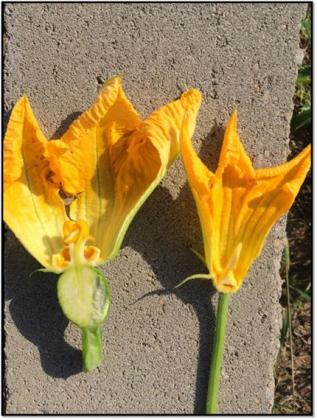
By: Richard Bogren, Kirk-Ballard Heather, LSU AgCenter Horticulturist
Are your squash, cucumbers or watermelon plants not producing fruit this summer? Extension agents across the state have been getting calls recently from home vegetable gardeners concerned that their plants are not making fruit.
It’s a good idea to have a little background information on cucurbit crops in order to understand why these things happen in our gardens. Cucurbits are those plants from the family Cucurbitaceae. They include such crops as cantaloupes, cucumbers, gourds, pumpkins, squashes, watermelons and zucchini.
First and most important to keep in mind is that cucurbits have both male and female flowers on the same plant. The male flowers emerge first and eventually fall off. Do not be alarmed by this. They do not produce fruit. You can tell the female from male flowers because the female will have a swollen growth just behind the flower. This is the ovary, and once fertilized by the male’s pollen, it will become the fruit.
Second, squash require the help of pollinators, especially bees, to carry the pollen from the male flower to the female flower. If you are seeing both male and female flowers on your plants and fruit is still not forming, then there may be an issue with pollination.
Let’s do some investigating. Do you see bees around? Flies and wasps can also do a great job of pollinating. Do you see them around the vegetable garden? If not, it may be because the bees, flies and wasps have found something else they’d like to pollinate. They have a great deal of flowering plants to choose from this time of year.
Have no fear. If you are seeing both flowers present but do not have the help of the bees, you can help.
Make sure you are able to properly identify male and female flowers. Remember, females will have a rounded, swollen-looking immature fruit beneath the flower. Once you identify the correct male and female flowers, just cut off the male flower stem and peel back the petals. Then touch the tip of the male flower to the tip of the female plant. You can also use a Q-tip to transfer pollen from the male flower to the female flower.
Voila. The female flower has been pollinated, and you should see fruit development.
If you are still not seeing the fruit develop, you could have other issues. Lack of fruit can also be seen in hot weather when pollen can be damaged by extreme temperatures.
Another consideration is water. How often are you watering? A heavy downpour can be both a blessing and a curse.
Excessive water after an extended drought can further add insult to injury. Cucurbits are susceptible to fungal disease such as powdery mildew, downy mildew and anthracnose. Extended wet and humid climates combined with hot temperatures are the perfect growing conditions for fungus.
It’s best to keep vegetable gardens as evenly watered as possible by way of irrigation or hand watering.
Avoid watering foliage and fruit because it encourages disease. It is best to water at the roots.
Additionally, if you are not seeing fruit, it could be a problem with fertilization.
Plants can appear healthy but may not produce fruit because they are getting too much fertilizer. Stop fertilizing for a bit if you suspect this is the case. If plants are pale and not growing as vigorously as they should, they are likely under fertilized. Apply a complete fertilizer such as 13-13-13 if this is the case.
Finally, are you having issues with insect pests? Slugs and snails in particular are real problems to deal with. Try a shallow pan filled with beer to lure them in at night. In the morning, you will find them trapped and can dispose of them. Then add more beer if you find they continue to pose a problem. Aphids, cucumber beetles, whiteflies, stink bugs and leaf-footed bugs can also be a problem. I do not recommend spraying home vegetable gardens because insecticides will also kill bees and other beneficial pollinators. You can try organic alternatives such as an insecticide that contains Bacillus thuringiensis dust or insecticidal soaps. Sometimes just removing bugs can get rid of the problem.
Squash require harvesting every other day for three to four weeks when producing. Pick them when they are small and tender at about 1 ½ to 2 inches in diameter and 4 to 6 inches long. Larger fruit will be of lesser quality. But be sure to remove all larger fruit from the vines to ensure continued fruit development.
Remember, a great garden is one you visit daily to catch issues as they arise so as not to get behind with bigger problems. It’s good for the garden and good for the mind and soul, too.
